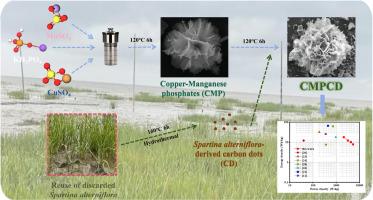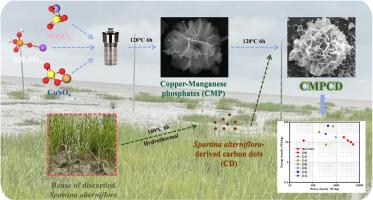入侵植物互花米草衍生的碳点/铜锰磷酸盐用于超级电容器电极
IF 5.6
3区 材料科学
Q1 ELECTROCHEMISTRY
引用次数: 0
摘要
互花米草是一种入侵植物,对沿海生态系统造成了严重的生态破坏。传统的物理管理方法产生了大量的生物质废弃物,可能导致二次环境污染。为了解决这个问题,我们提出了一种可持续的策略,将互花米草转化为高价值的碳材料,减轻环境危害,同时提高超级电容器电极的电化学性能。尽管双金属磷酸盐具有很高的储能潜力,但在循环过程中面临着体积变化大、动力学性能差等挑战。从互花米草中提取的碳点具有纳米级尺寸、优异的光电性能、高稳定性和环境相容性等优点,有效地解决了这些局限性。CMPCD-2(掺杂2mg碳点的铜锰双金属磷酸盐)复合材料在0.5 a /g时具有277 F/g的比电容。以CMPCD-2电极为正极,活性炭为负极构建的非对称超级电容器(ASC)器件,在2.1 kW kg-1的功率密度下,实现了17.8 Wh kg-1的能量密度。本研究不仅推动了双金属磷酸盐储能材料的发展,也为互花米草资源的有效利用、生态修复与储能技术的衔接提供了可持续的解决方案。本文章由计算机程序翻译,如有差异,请以英文原文为准。


Invasive plants Spartina alterniflora-derived carbon quantum dots/copper-manganese phosphates for supercapacitor electrodes
Spartina alterniflora, an invasive plant species, has caused significant ecological damage to coastal ecosystems. Traditional physical management methods generate substantial biomass waste, potentially leading to secondary environmental pollution. To address this, we propose a sustainable strategy to convert Spartina alterniflora into high-value carbon materials, mitigating environmental harm while enhancing the electrochemical performance of supercapacitor electrodes. Bimetallic phosphates, despite their high energy storage potential, face challenges such as large volume changes during cycling and poor kinetic performance. Carbon quantum dots, derived from Spartina alterniflora, offer advantages such as nanoscale dimensions, excellent photoelectric properties, high stability, and environmental compatibility, effectively addressing these limitations. The CMPCD-2 (Copper-manganese bimetallic phosphates doped with 2 mg of carbon quantum dots) composite demonstrated a specific capacitance of 277 F/g at 0.5 A/g. An asymmetric supercapacitor (ASC) device, constructed with the CMPCD-2 electrode as the positive electrode and activated carbon as the negative electrode, achieved an energy density of 17.8 Wh kg-1 at a power density of 2.1 kW kg-1. This work not only advances the development of bimetallic phosphate-based materials for energy storage but also provides a sustainable solution for the effective utilization of Spartina alterniflora, bridging ecological restoration and energy storage technology.
求助全文
通过发布文献求助,成功后即可免费获取论文全文。
去求助
来源期刊

Electrochimica Acta
工程技术-电化学
CiteScore
11.30
自引率
6.10%
发文量
1634
审稿时长
41 days
期刊介绍:
Electrochimica Acta is an international journal. It is intended for the publication of both original work and reviews in the field of electrochemistry. Electrochemistry should be interpreted to mean any of the research fields covered by the Divisions of the International Society of Electrochemistry listed below, as well as emerging scientific domains covered by ISE New Topics Committee.
 求助内容:
求助内容: 应助结果提醒方式:
应助结果提醒方式:


